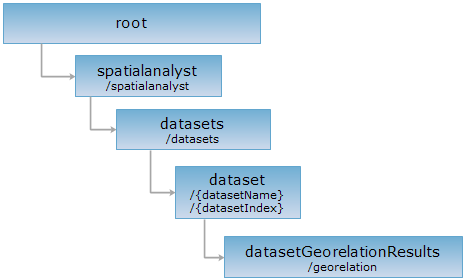
<dataset_uri>/georelation[.<format>]
Send POST request to this resource to create a datasetGeorelationResult resource.
Supported Methods:
Supported output formats: rjson, json, html, xml.

Implement the HTTP request on the following URI, where supermapiserver is the server name, with rjson being the output format.
http://supermapiserver:8090/iserver/services/spatialanalyst-changchun/restjsr/spatialanalyst/datasets/BusLine@Changchun/georelation.rjson
Returns a form for the POST request.
Creates the resource of a geographic relation analysis result, i.e., performs geographic relation analysis.
The following parameters are needed in the request body
| Name | Type | Description |
| sourceFilter | QueryParameter | The source dataset query parameter in geographic relation analysis, only ids, attributeFilter and fields are available. |
| referenceFilter | QueryParameter | The reference dataset query parameter in geographic relation analysis, only ids, attributeFilter and name are available. |
| spatialRelationType | SpatialRelationType | The spatial relation type specified. |
| isBorderInside | boolean | Whether the point on the border is inside the polygon. This parameter is only used for the condition that the spatial relation is contain or within. |
| returnFeature | boolean | Whether to return Feature information. |
| returnGeoRelatedOnly | boolean | Only return the spatial object that meet the specified spatial relationship, the default is True. |
| startRecord | int | The start record position of the analysis result, the default is 0. |
| expectCount | int | The count of result record except the return, the default is 500, return all the results if there are not 500. |
| Field | Type | Description |
| succeed | boolean | Whether the analysis is successful. |
| newResourceID | String | The ID for the analysis result resource. |
| postResultType | PostResultType |
The result type fo the POST request. |
| newResourceLocation | String | The URI of the newly created resource. |
Perform POST request on http://localhost:8090/iserver/services/spatialanalyst-changchun/restjsr/spatialanalyst/datasets/BusLine@Changchun/georelation.rjson the request body is as the following:
{
"isBorderInside": true,
"sourceFilter": {
"attributeFilter": "SMID%26gt;0"
},
"referenceFilter": {
"name": "Railway@Changchun",
"attributeFilter": "SMID%26gt;0"
},
"startRecord": 0,
"expectCount": 20,
"spatialRelationType": "INTERSECT",
"returnFeature": false,
"returnGeoRelatedOnly": true
}
The request result in rjson format returned is as follows:
{
"succeed": true,
"newResourceID": "xqzxg79p_ce128f528e0a4a0fbd2afba79780ee04",
"postResultType": "CreateChild",
"newResourceLocation": "http://localhost:8090/iserver/services/spatialanalyst-changchun/restjsr/spatialanalyst/datasets/BusLine@Changchun/georelation/xqzxg79p_ce128f528e0a4a0fbd2afba79780ee04"
}
Performing a GET request on http://localhost:8090/iserver/services/spatialanalyst-changchun/restjsr/spatialanalyst/datasets/BusLine@Changchun/georelation/xqzxg79p_ce128f528e0a4a0fbd2afba79780ee04.rjson can retrieve detailed information about the analysis result. Please see datasetIsolineResult.
Asks for the response identical to the one that would correspond to a GET request, but without the response body. This is useful for retrieving meta-information written in response headers, without having to transport the entire content. The meta-information includes the media-type, content-encoding, transfer-encoding, content-length, etc.
HEAD request can be used to check if the datasetGeorelationResults resource exists, or if the resource can be accessed by clients. It can also determine if the datasetGeorelationResults resource supports an output format <format> if performed on a URI with .<format> included.